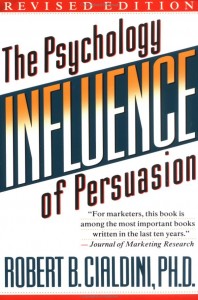The Art of Influencing Your Web Visitors to Improve Conversions
Last updated | Just how good is your website at influencing and converting your many visitors? Unfortunately it’s not good enough anymore to just rely on a great looking website or having the lowest prices – you need to understand your visitors mind and influence it to the best of your ability. But how can you learn how to do that without taking a class in psychology?
Just how good is your website at influencing and converting your many visitors? Unfortunately it’s not good enough anymore to just rely on a great looking website or having the lowest prices – you need to understand your visitors mind and influence it to the best of your ability. But how can you learn how to do that without taking a class in psychology?
One of the best ways to do this is to learn from the principles of a true expert – Dr Robert Cialdini. He wrote an outstanding book called ‘Influence: The Psychology of Persuasion that reveals six weapons of influence that can be used to great affect, even in the online world. The basic premise of his book is that in our increasingly complex and pressured world, we often make decisions by falling back on his six instinctive patterns – and that many smart marketers and sales people make use of these patterns to influence and convince their potential customers with great results.
Therefore, I thought I would tranlsate Robert Cialdini’s six great principles to the online world with some examples, hopefully helping you understand how you can influence your website visitors better, thus converting more of them and keeping them coming back for more (without them even realizing how you are influencing them so well!)
Let’s get started – here are his six ‘weapons of influence’ adapted by me so you can take advantage of these on your websites:
1: Reciprocity– Cialdini’s first principle states that people tend to return a favor once you give them one – therefore you can capitalize on this. In the online world, this basically equates to giving them something for free on your website:
- a free white paper or ebook that helps your visitors understand your industry or product better, or offers tips and advice.
- free shipping offers for your visitors (like on purchases above $25).
- a free time-limited or featured-limited trial of your product or service.
Once you do this, Cialdini’s principle states that people will be much more likely to return the favor, by purchasing something from you, or coming back for more. And if you get their email in exchange for your ‘free’ favor, you can even contact them if they don’t come back.
2: Commitment and consistency– His second principle states people tend be true to their previous behaviour and like to remain consistent with this. To apply this principal on your websites to influence more visitors you should try doing these:
- Don’t go changing things too often on your website – you will alienate your most committed and most valuable visitors.
- When your visitors make a purchase, automatically send them a coupon for a discount on a future purchase.
- Send automated emails to your registered users reminding them of new features or special offers on your website.
If you apply any of these principles online, Cialdini would say that your visitors would be far more likely to keep returning to your website to maintain their consistency and commitment.
3: Social proof – For this particularly powerful but simple principle, Cialdini believes that people will be far more likely to do something if they see many others also doing it. This can be applied online in the following ways:
- encourage visitors to create customer reviews on your products or services and make these a key feature on your related pages (amazon.com do a particularly great job of this).
- get as many testimonials from existing customers/clients and prominently place on your website (ideally place them in their own section too).
- create a Facebook fan page and intergrate it into your website so visitors can see how many Facebook users like your site.
4: Authority– Cialdini’s next principle states that people tend to obey authority figures. This can be applied online by the using following on your website:
- get testimonials and reviews from celebrities and experts and then prominently place them on your website. To increase the effects of this, get these from relevant experts like doctors, lawyers, cops or teachers, and show them in their relevant uniform or work attire.
- prominently place credibility badges on your website like better business bureau (BBB) logos, hacker safe badges and security seals. Placing these near points of purchase or shopping cart ads will have extra influence.
5: Liking – His next principle states that people are easily persuaded by other people that they like and states the Tupperware phenomenon as the perfect illustration. Here are some ways that you can apply this principle online:
- encourage social sharing of your content by embedding share links, particularly for Facebook and Twitter (TellaFriend.com works great).
- create special promotions that give discounts to visitors who get their friends to join up or purchase on your website.
- create viral marketing related offerings that encourage visitors to share content with their friends (think ElfYourself.com).
6: Scarcity– Cialdini’s last principle states that perceived scarcity generates demand, regardless of how good the thing actually is or whether we really need it. Here are some ideas for how to take advantage of scarcity for your website:
- make use of ‘limited time only’ web specials and discounts. Reinforce this each day by stating how many days are remaining for the offer.
- make it obvious what the visitor will lose by not buying or signing up, particularly how much money they will lose – this adds to the power of the scarcity principle.
- if possible, make limited quantities available on your site when launching new products (think of the iPhone success, even with lack of initial supply).
Hopefully you found my online adapted principles of Robert Cialdini very interesting and thought provoking. And if you haven’t read ‘Influence: The Psychology of Persuasion‘ I strongly recommend that ANYONE in online marketing or web analytics/optimization read this. Its extraordinarily eye-opening – I definitely found huge value in this and adapting its principles to the online world.



